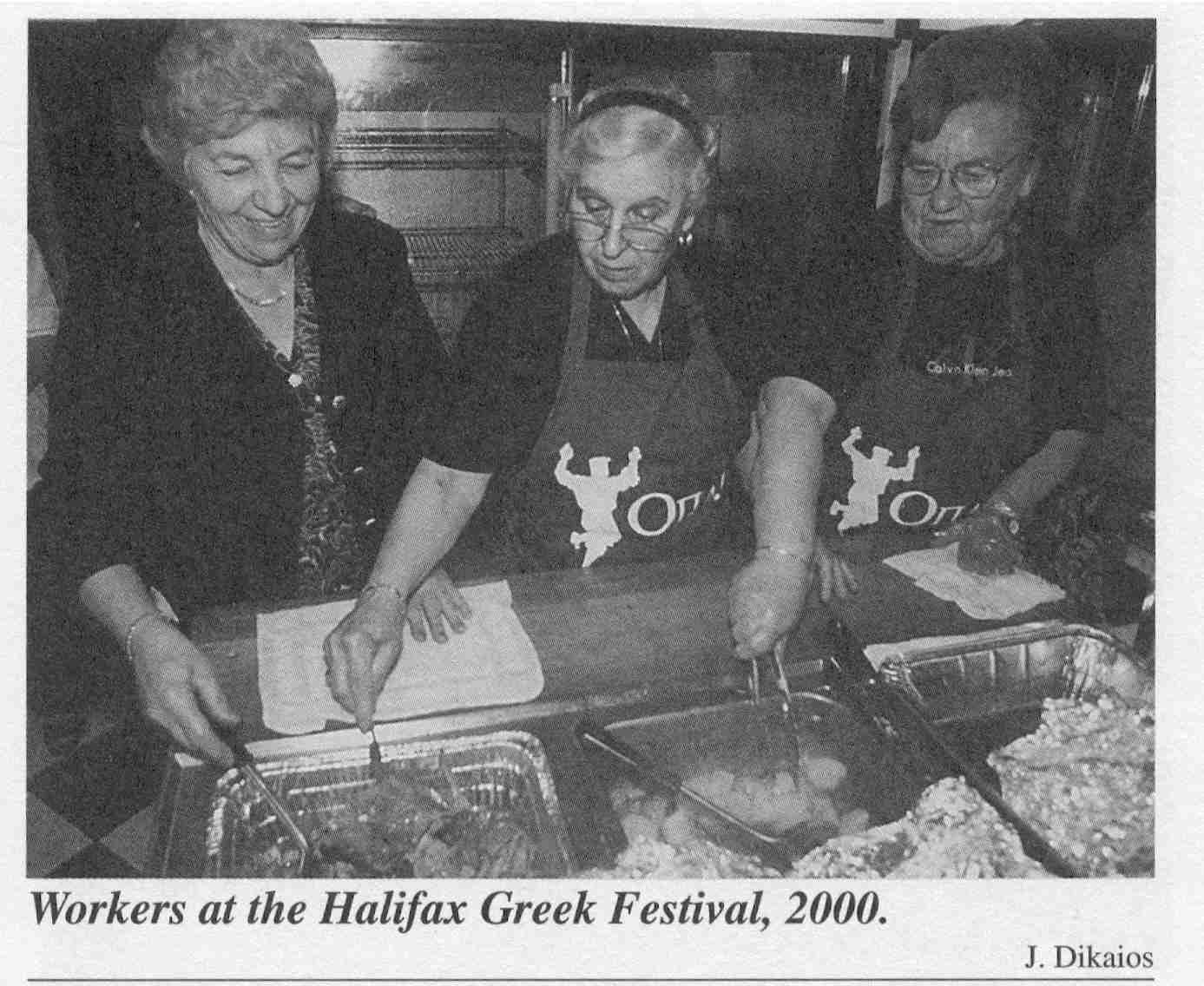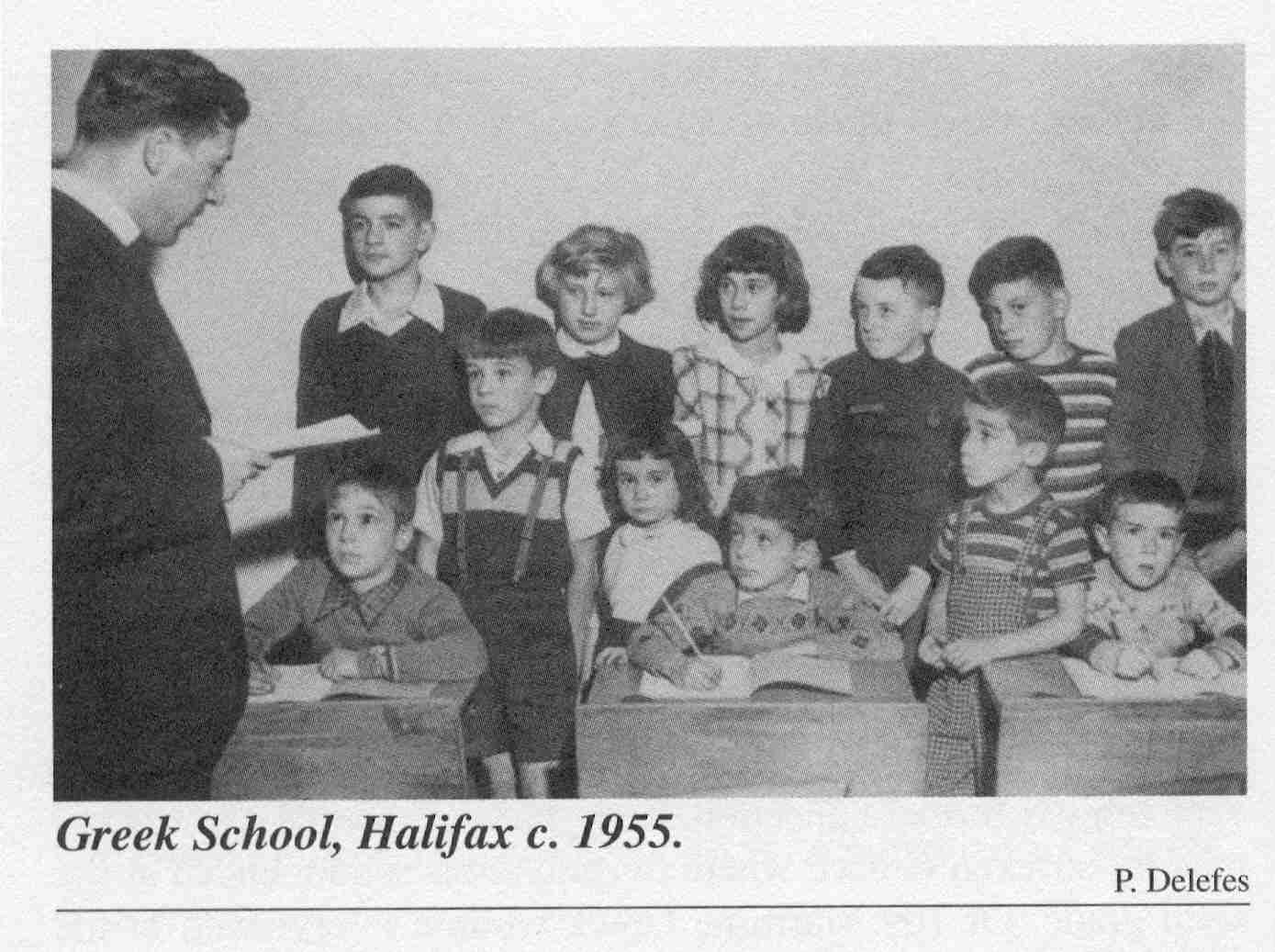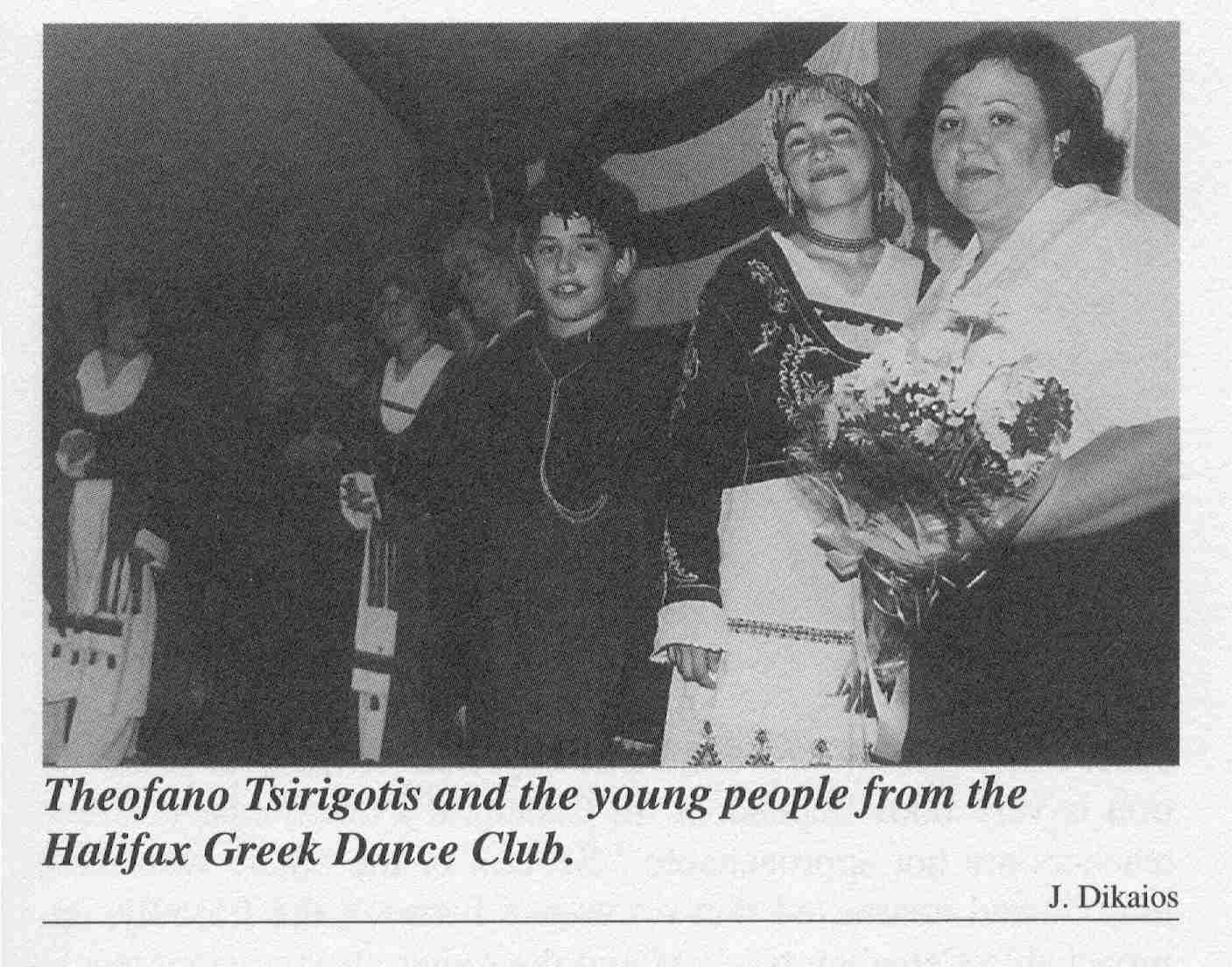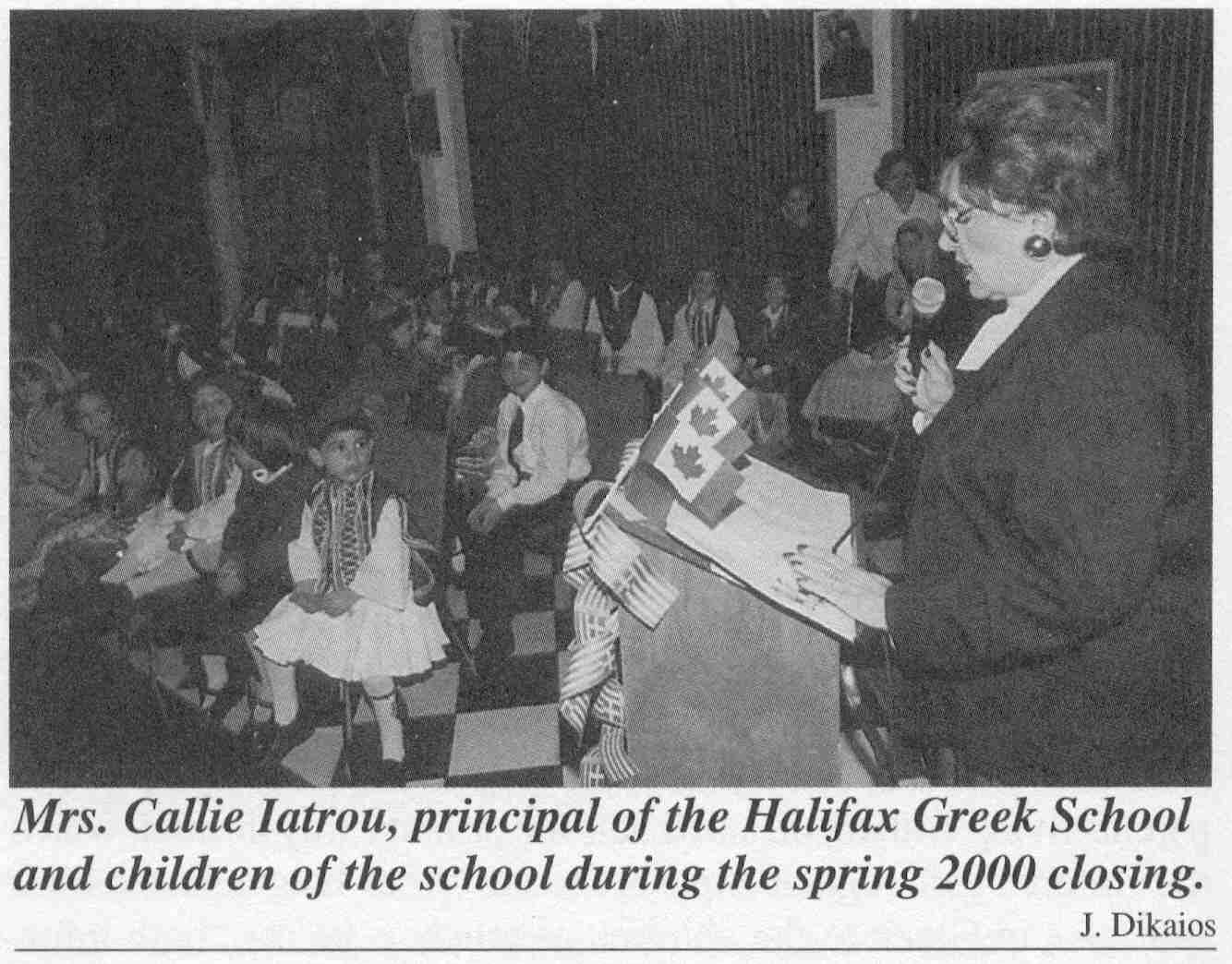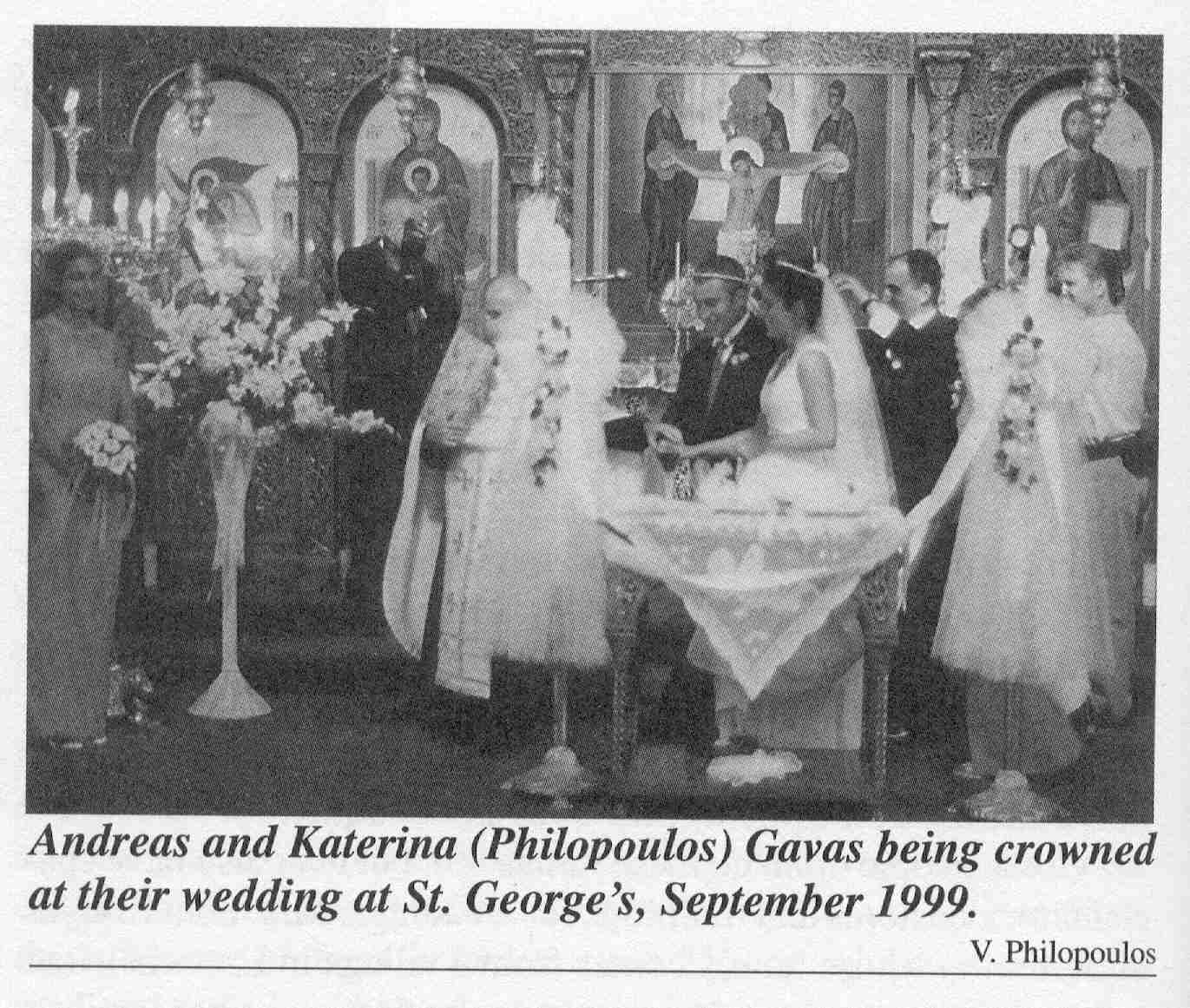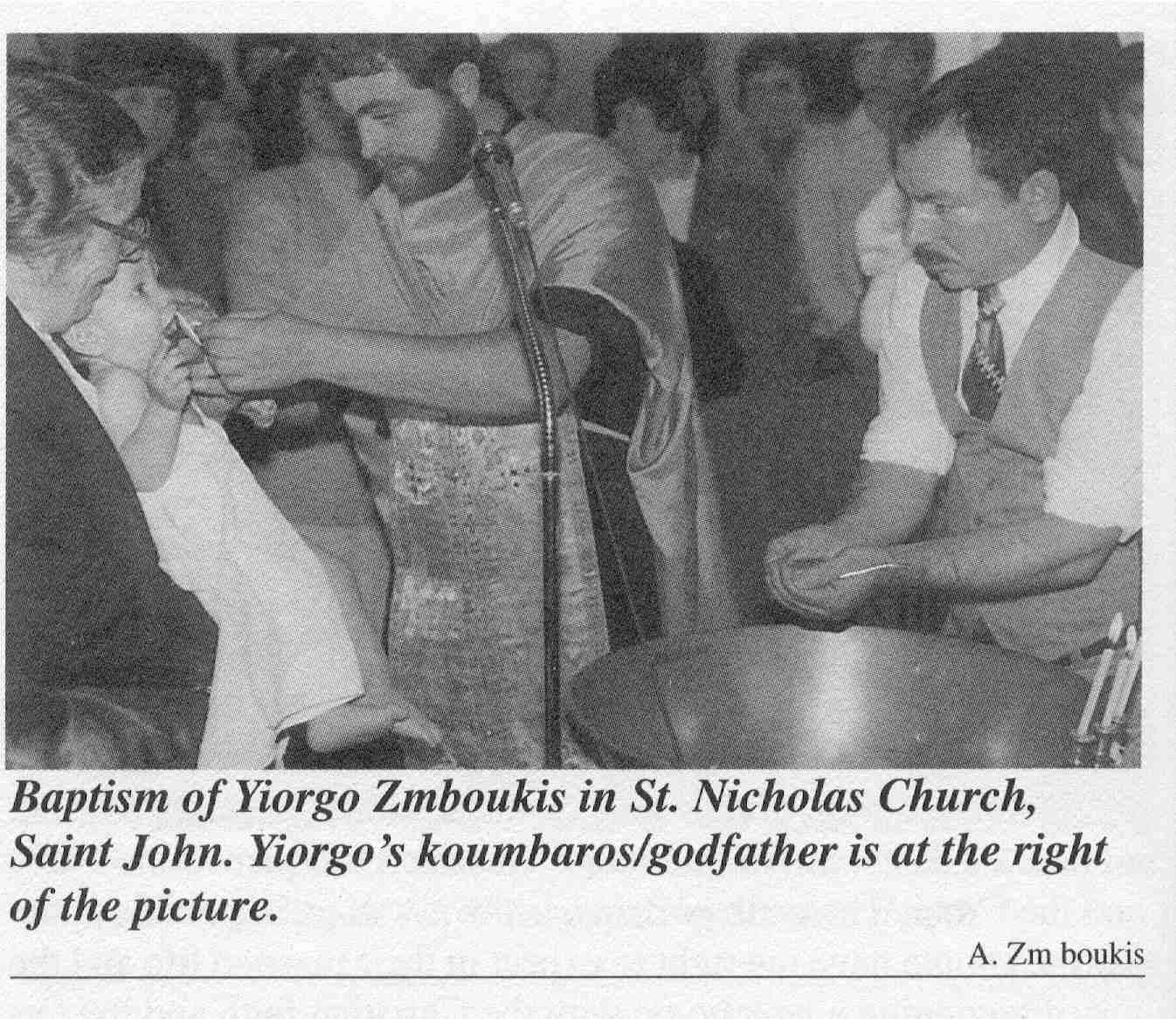IV.
Society, Culture, Education, and Language
The Greek people of the Maritimes
are as diverse in their behavior and interests as any other group. Yet they have certain common traits which
tend to be particularly characteristic of them as Greek Canadians. Current (1996) statistics figures provided by
Statistics Canada show that 83% of all adult Greeks in this area are married, and that only 1.6% of them have had a divorce. While it is very much changing with a younger
generation, the Maritime Greeks always tended to prefer Greek Canadians or
Greeks from
In Maritime Greek homes family
strength and unity are all-important. We
often find that the married couple has a strong sense of partnership. Many husbands and wives have worked closely together for years in developing and sharing
the responsibility for a family business.
In those homes as the children grow into their teens, they often take
turns looking after the small diners, pizza places, or stores which their
parents own. Greek parents consider
their children (and almost every Maritime Greek family has children) to be the
centre of the home. When it is possible,
the family travels to
In the past, the mother of young
children normally stayed home, and children were rarely left with anyone
outside the immediate family. A few
years ago the author’s interviewers could not even find a word for
"babysitter" in the vocabulary of Canadian Greeks in
Most middle-aged and senior Greek women,
even if they work outside the home, take pride in cooking traditional Greek
food. Some of the Maritime Greek homes
have a grandmother or yiayia, who
lives with her married children, and does most of the traditional cooking. The children have learned to enjoy roast
lamb, moussaka (a sort of ground
meat and eggplant casserole), spanakopita
(spinach pie), and kourambiethes
(butter cookies). When the Greek Church or one of its organizations puts on a
social event or fundraising activity, the women of the Greek community are
called on to produce Greek food, sometimes in great quantities, for the event. Whether or not the women are directly
associated with the group requesting the food, or
whether they may themselves have major time commitments in other areas of their
lives, most inevitably and cheerfully comply with the request. One concern in the area of food preparation
is that some of the younger Greek women have not learned, or have not had the
time to do traditional Greek cooking.
The older women are sometimes quite protective of their recipes and
unwilling to share them with a younger generation. Some of the younger women in the community
are now beginning to realize that if they do not soon learn the preparation of
the traditional dishes, those skills will die out with the passing of the older
members of the community.
Also characteristic of most Maritime Greeks
is a strong interest and pride in their culture. I have already talked about the great
enthusiasm the young people in the Halifax area show in learning and performing
the traditional dances from Greece.
Teens and adults alike also want to learn something about the glories
and struggles of their Greek past. At local universities such as Dalhousie and
Saint Mary's professors who offer courses in Greek History, Mythology, and
Ancient Art regularly find that they have one, two, or more students of Greek
background in their classes. In the
Halifax area it is common for leaders of the Greek Church or for individuals in
the Greek community to invite guest speakers to come and talk about the history
and culture of both ancient and modern Greece.
Many Greek homes contain pictures and artifacts from Greece. Brightly woven fabrics, copies of Greek
museum pieces, and antique brass dishes hold pride of place as home
decorations.
Today most Greek families in the
Maritimes prefer not to live too close to one another. Some are quite adamant that they do not want
to live in any sort of Greek enclave, and have told interviewers that "we
will move if any other Greeks move into this neighborhood." In Halifax with increased prosperity many
have moved out of the older parts of the city and now live in the west or
central parts of town. Some families are moving outside the peninsula to
recently-developed areas in Dartmouth, Clayton Park, and the Purcell's Cove
Road area where the new St. George's Church is located.
While in large Greek cities there is
much socializing and interaction between men and women in the cafes, dance
halls, and restaurants, in the villages men still congregate daily at the local
coffee shop or kafenion to smoke, snack, and catch up on all the local
gossip. Women are almost unknown in such
establishments. As we have seen, early
on the kafenion became a regular part of daily life for Greek men in North America. A very modified version of the kafenion
environment exists in the Maritimes today.
It is not unusual to see local Greek businessmen in Halifax visiting one
another's stores and restaurants during the day, and stopping for a chat and a
coffee. Other Halifax men of Greek descent spend time at The Club in the city's
downtown where they can relax, shoot some pool, and have a drink in a primarily
male environment. Greek men in Saint
John regularly drop in at the popular Vito’s Restaurant for a coffee or lunch
together.
While there are certainly
exceptions, many of the immigrants who came to the Maritimes after the First or
Second World War had very limited formal education. They had left behind a war-torn,
poverty-stricken Greece where in rural areas school ended at the sixth grade. Of 109 Maritime Greek women interviewed in
the 1980s, two (1.8%) had never been to school, thirty (28%) had an elementary
school education, three (2.8%) went as far as junior high, forty-three (39.5%)
had partial or complete high school, and thirty-one (28.4%) had been to
university. At the time of the
interviews most of the women who had completed high school or been to
university were under forty, or were from the few families who had emigrated
before World War II and had been educated in Canada. Many of those women who came to Canada from
Greece before 1955 never acquired much fluency in English. They arrived with little or no skill in the
language and they had few contacts outside the family and Greek social
circle. While their husbands did learn
enough basic English to survive in their shops and small business, the women
generally did not. Mrs. Katina Manos of
New Glasgow who died at 89 in 1991 is typical of the older generation. She and her husband had come to the New
Glasgow area of Nova Scotia in the 1920s.
Some years ago in an interview conducted in Greek she explained that in
her small village near Sparta she had never had the opportunity to go to
school. Her poignant words were "it
was more important to keep alive."
Mrs. Manos had six children educated
in Nova Scotia. The girls'
education ended at junior high school, but her two youngest children, both
sons, went on to complete university.
One son, Dr. James Manos, is now a university professor and the other,
George Manos, was principal of a school and now is a county councillor in New
Glasgow. All of Mrs. Manos' elder
grandchildren are now studying in university, and James Manos’ two daughters,
Daria and Sarah, are both in medical school.
As the older generation of monolingual Greek speakers gradually slips
away, so too do the problems of living in a language, culture, and educational
environment different from the life which they had left in Greece.
Greek families of the Maritimes
today are characterized by a fierce determination to educate their children in
as broad a range of subjects as possible.
Several Greek families in the Maritimes send their children to French
immersion programs where these programs are available. These children learn French as well as
English in day school, and then learn Greek at home and in Greek school at
night. Older Greeks who themselves faced difficulties in receiving an
adequate education in Greece are determined that their children and
grandchildren shall stay in school as long as possible. The parents are willing to make real personal
sacrifices in order to provide for their children's education and ensure a life
of opportunity. Because of their
parents' support, few Greek Canadian young people need to take out student
loans. Today many young Greek Canadians
in the Maritimes have entered and successfully completed undergraduate and
graduate degree programs in a variety of fields. They are becoming established as medical
doctors, lawyers, engineers, accountants, successful business people and
educators. In the Maritime Greek
community young and old alike see education as the key to future success.
IV.3
Preservation of the Greek Language
The determination to preserve the Greek
language in North America and pass it on to the next generation is one of the
most important cultural goals of North American Greeks. Many Maritime Greeks keep the Greek language
alive by speaking it at home and by frequent travel to Greece. The priest at St. Nicholas’ Church in Saint
John points out that many Greek Canadian families have grandparents living with
them, and that is the primary way through which the children gain regular
exposure to the Greek language. He himself talks in Greek to the children as
much as he can, both informally, and as their teacher in the Saint John Greek
School. Greek schools have been in North America since 1931 and in Halifax
since the 1950s. According to the
principal, Callie Iatrou, the Greek School in Halifax, which goes from grades
one to six, and employs two teachers, presently enrolls about 60 children. That number is down from the high enrollment
days of the 1970s and 80s when the school contained over 150 students. However, a recent increase in the number of
Greek babies in the community suggests that the number of children for the
school will rise again within the next couple of years.
Since the Halifax Greek School
operates as a twice weekly, evening program after the regular school day, it
puts pressure on both students and parents alike. Funding for the teachers' salaries comes from
a fee paid by participating families, fundraising activities organized by the
school board, and donations of the Church Council. The Greek government, which supplies a large
number of books for the different grades, also provides accreditation for the
school. In theory that means that a
pupil who completes a particular grade in the Halifax Greek School could pass
into the next sequential grade if that child's family moved to Greece. However, given life in a Canadian context, where
the children are surrounded by the English language in their daily lives, it is
very difficult to make a smooth transition from schooling in Canada to that in
Greece. According to Mrs. Iatrou, many
children attending the Greek school in Halifax now come from homes where Greek
is not spoken as frequently as in the homes of earlier generations of Greeks in
the Maritimes. Thus it is a struggle for
the school to maintain the same standards of spoken and written competence in
the Greek language as in the past.
Anyone who wants to learn to read and
write Greek has to learn not only a new vocabulary and new, often complicated
grammatical forms, but also a completely different alphabet. That alphabet of twenty-four letters does not
correspond exactly with the western or Latin alphabet, as there are, for
example, two different "o" vowels. What sounds like "e" to
an English trained ear can have a number of spelling possibilities in
Greek. In addition, some of the capital
letters look very different from the forms used for the lower case
letters. Increasingly, Greek schools
rely on books published in North America rather than in Greece, because the
North American materials use a teaching/learning style likely to be more
familiar to children educated in Canadian schools.
Along with education in the Greek
language comes a strong measure of Greek religion, traditions, mythology, and
history. For Christmas and at the end of
the school year the children give public presentations of poems, songs, and
plays. The Greek schools also foster a
strong feeling of pride for the Greek homeland, one that is founded on the
glories of ancient and modern Greece.
Days such as March 25 or October 28
are of special importance for all Greeks, as they remember their
ancestors' struggle for independence from the Turkish and Italian rulers of the
past. On those days children in the
Halifax Greek School present patriotic poems which they have memorized, put on
plays, and perform traditional Greek folk dances. The dancing itself is a regular, weekly part
of the Halifax Greek School's activities in addition to the more academic
studies.
In the past St. George's in Halifax
has also run Greek language classes for interested adults, but in recent years
such language classes have become available outside the church through Saint
Mary's University. Prof. Niki Hare, who
is a Greek Canadian born in Cyprus, gives these classes. Adult learners of Greek tend to be those with
a strong interest in Greek culture, and a fondness for Greece itself. Some students are not Greek by background.
Others are Greek Canadians who wish to improve their Greek, especially their
reading and skills. Still other adult
students have married local Greeks and wish to feel closer to their spouses'
proud cultural and linguistic heritage.
IV.4
Stories, Customs, and Traditions
In each society and ethnic community
there exist stories, customs, and traditions which add unique features and
color to the life of the people. Since
the time of ancient Greece the making of stories and particularly the creation
of myths have been characteristic of the Greek people.
This first story is from a Halifax
Greek lady whose family comes from the village of Xerokampi, near Sparta in
southern Greece. Here are her own words:
"My mother told me a very
moving story about St. Nikonas where an interesting custom about the baking of
the church bread (prosforo) is
revealed. St. Nikonas was a well-known
saint around the Peloponnese, because he was supposed to have visited it after walking across the Aegean Sea from Asia
Minor. He preached in the Peloponnese
and died there, but nobody knew the place where he had been buried. One night a little boy, bearing the saint's
name, had a dream in which the saint revealed to him where his bones lay. When the little boy told his mother, she was
first frightened and did not say anything.
Finally she told the priest who summoned the whole village of Xerokampi
into a meeting. They all took their
shovels and started digging until they found the holy bones. Then they transferred the bones to Sparta
where they built a magnificent cathedral bearing St. Nikonas' name.
All the villagers took home with
them a little bit of the earth that held the saint's bones. My mother's aunt took some, and when she baked the bread to take to the
church for her husband's mnemosyno
or anniversary service for his death, she put a tiny bit of the earth in the
dough. She made two round loaves and stamped
them, but one of them looked cracked.
That one she gave to a poor man and the other she took to church. When she went to sleep the next night, she
dreamed that her husband was thanking her profusely for the great gift which
she had sent him. She was surprised for
she didn't think that she had done anything special. In her dream her husband pointed at the
cracked loaf, which he was holding in his hand.
That loaf was the one which she had given away. Her husband was pointing at a tiny piece of bone,
St. Nikonas' bone, in the loaf. St.
Nikonas' feast day is the 26th of November."
The Greek people of the Maritimes
have brought with them customs and traditions that are important to them as
individuals, as families, and as members of a community. In this book customs are defined as practices which are done over and over again
by individuals and by families. These
customs may only exist across the life of one person or one family, or they may
have lived in a particular family for a number of generations. While some Greek families in the Maritimes
have customs similar to those in other families, there are often real
differences among families. Traditions are defined as ways of doing things, which are often
hundreds of years old and are held in common by a great number of people. Even within common customs and traditions
certain modifications can be found from one family to another and one region to
another.. Described below are some
customs and traditions which the Greek people of the Maritimes have remembered
and brought, sometimes in a modified form, from Greece. Expect to discover slight variations as
people from different parts of Greece tell their stories.
A wedding always demands special
ways of doing things to help make the occasion memorable. Anyone planning a wedding begins to consider
styles of clothing, types of food, the nature of the ceremony, and the use of
special, old customs which make us laugh, but also are maintained because
‘that's the way it always is at weddings’.
Most of us are familiar with wedding customs such as the garter, which
the bride wears on her leg and the new groom removes. We throw confetti or rice at weddings, and at
the reception’s end the new bride throws away her bouquet.
Greek people often do these things
too, but they also have special Greek customs and traditions for weddings. Mrs. Pota Kouyas of Stellarton whose family
comes from a village in Laconia in the southern Peloponnese, told an
interviewer that it was her family's custom to give a bride and groom each a
spoonful of honey to eat in order to sweeten their marriage and their married
life together. She also said that
friends of the newlyweds place a horseshoe on the threshold of their new home,
and that the bride and groom each step on it as they enter. This brings good luck to the marriage. Mrs. Sophronia Georgakakos of Halifax, whose
family also came originally from the southern Peloponnese, but from another
village, added her versions of these wedding customs. Mrs. Georgakakos said, "When the
marriage ceremony in my part of Greece is over and the bride and groom go home,
they find that the bridegroom's family has placed a steel bar at the entrance
to the house and on the top of the door so that the couple will have a strong marriage. The bridegroom's family also makes up a cross
with honey so the bride will be ‘sweet’ for her new husband."
Mrs. Bessie Katsepontes who is from
the village of Palaiopanayia, also near Sparta, gave us her version of the
‘sweet’ wedding stories. She said,
"In our village before the wedding young village girls- and they must be
unmarried girls- come to decorate the new couple's bed and room with sweets-
usually almonds- which they hide in the new sheets. Sometimes they play small tricks on the
couple with the funny things they hide in their bedroom. After the church wedding when they are back
in the groom's home, his mother gives the new bride honey in a silver
spoon. After the bride has eaten the
honey, she throws the spoon behind her.
Whoever catches the spoon can take it home as a souvenir."
Greek weddings in the Orthodox
Church have several features, which are both colorful and traditional. First, the principal, official sponsors or
attendants of the new couple, the koumbaros
(male) and koumbara (female), must
be Orthodox and in good standing with the Church. They may be relatives of the young couple,
but need not be. Even if not related,
the koumbaroi (plural) are treated
almost like family, and often will be asked to be the godparents of the new
couple's first child. In the wedding
itself the crowning of the bride and groom is the climax of the service. Before the wedding the
priest has
placed a tray holding two crowns on a small table at the front of the
church. The stephana or crowns of fresh or artificial flowers are joined by a
single ribbon and signify the glory and honour with which God is crowning the
couple. The church teaches that on earth
they are being crowned as the king and queen of their own little kingdom, which
they will rule with wisdom, justice and integrity. When the crowning begins, the priest takes
the crowns and holds them above the couple saying,
“The servants of God
(name) and (name) are crowned
in the name of the
Father, and of the Son, and of the Holy Spirit. Amen.”
The koumbaros and koumbara then
simultaneously switch the crowns three times above the heads of the bride and
groom to demonstrate that they are being crowned in equality, dignity, and mutual
love and support. Usually the crowns are
preserved carefully at home on a stand or in a special case close to the
marriage bed, and preferably they are never touched or disturbed, to avoid the
possibility that the marriage itself might be disturbed. Near the end of the wedding service, the
priest leads the bride and groom in a circle or dance around the table on which
are placed the Bible and the Cross. The
walk or dance is always done in great joy- the joy the couple have the right to
expect in their married life and the joy of beginning a new home with the
Christian faith and the Orthodox Church at the centre of their life together.
In Maritime Greek homes January 1st,
St. Basil’s special day, brings some of the most popular traditions which have
been transferred from Greece to Canada.
Mrs. Antonia Xidos, whose family comes from the island of Milos, told us
that early on January 1st her youngest son, Dino, appears at the doors of the
various family members, bringing with him rocks he has picked up on the
seashore. She said: “He places a rock
for luck and so the coming year will be strong like the rock under the bed of
the husband and wife in the home.” Mrs. Xidos’ married daughter, Cathy
Mavrogiannis, laughingly admits that she now has a collection of rocks from
numerous years under her bed. Her mother
says that it is all right to replace last year’s rock with this year’s
‘present’, but Cathy is not taking any chances!
Each household bakes its own Vasilopita
(cake or bread for St. Basil) to mark the beginning of another year. Everyone hopes to get a lucky coin baked
inside the cake or pita.
The Vasilopita commemorates a miracle
performed by St. Basil while he was a bishop.
The legend varies as to how St. Basil became the guardian of the gold,
silver, and jewelry of the people of Caesarea in Asia Minor. Some sources say that thieves had taken the
valuables from the village and that they were recovered. Other sources say that the treasures had
first been required as a tax by a hostile, pagan Roman governor, but that he
was so impressed by St. Basil that he returned the people's treasure to this
good man. In either case St. Basil was
supposed to return the treasures to the owners.
However, the villagers could not agree on who owned each particular
valuable piece. St. Basil suggested that
the women should bake the valuables inside a large cake or pita. When St. Basil cut the pita, each owner
miraculously received his or her own treasure.
Today a single coin is baked inside each loaf to honour St. Basil's
miracle, and the one who gets the coins is supposed to receive good luck for
the coming year. Greek people cut the
first piece of the Vasilopita at midnight on New Year's Eve. The head of the
household first says a blessing and then cuts the cake into pieces in a
specific order which remembers Christ and the saints, as well as family and
friends gathered at the table. In Greece
(and we suspect in some Greek Canadian households), a little Vasilopita and
some other food may be left out for St. Basil on his name day, January
1st. Anastasia Botas of Halifax told us
that in her home they don't receive presents on Christmas Day, but the presents
do appear with Saint Basil at New Year's.
Like weddings, deaths and funerals
attract patterns of traditional behaviour, which can be very tenacious. Several of our Maritime Greeks have told us
about death rituals from the southern Peloponnese in which the mourners,
usually the local women, create elaborate songs and poems (moirologia) to chant and sing beside the body of the dead
person. The family of Mrs. Chrysoulla
Raptis of Sydney came from Gythio south of Sparta. Mrs. Raptis said, "When my father died,
all the mirrors were covered with black ribbons. When someone has died, the people sit up all
night around the body. After someone is
dead and has been buried for three or four years, they take up the bones and
wash them with wine, put them in a box, and keep them in the church. When the family and friends go to the
'opening up’ ceremony, they say 'we're going to free so and so'. That means the earth somehow keeps the spirit
enslaved, and when the bones are out, the spirit feels free. When we were children, we were terrified to
go near that room full of bones at the church.”
While we in North America may find the
whole idea of the 'opening up' ceremony more than slightly macabre, it should
be understood, at least in part, as a practical way to avoid the expansion of
cemeteries. With this custom the family
tomb is available when the next member of the family dies, and the remains of
the one who has died previously are dealt with in a way that tradition and
church consider acceptable.
Because it is a different cultural
climate, and because Canada has stringent regulations about the disposal of
dead bodies, the practice of the ‘opening up’ ceremony does not exist in
Canada. However, Greek families do use
other rituals around death which are hallowed by their traditions, and which
help them deal with the terrible finality of losing a loved one. In some families it is still common for the
women to adopt total or almost total black in their clothing for a period up to
one year after the death of a close family member. Some women who are widowed may never remove
that black clothing. They are not
required by any church or community regulations to dress in this way. In fact, in some situations other members of
a woman's own family may find the totality of the black grim and hard to
endure, and ask for its removal. But
those women themselves feel comforted by their black attire; they feel that
they want to indicate to the world the grief that is within their hearts. Who, then, should look askance at their
dress?
The Greek memorial service or mnemosyno which occurs forty days after
the death of a relative, and special days of remembrance for the dead
throughout the church year are other ways through which Canadian Greeks deal
with feelings of bereavement. On those
remembrance days the women prepare, bring to the church, and share with friends
and family a traditional memorial dish called kolliva. This is made of
boiled wheat mixed with sugar, pomegranate seeds, and spices. The kolliva is a symbolic message of
everlasting life and hope. For Greek
Christians it is rooted in the words of St. John’s Gospel 12:24 where it says,
“Truly, truly, I say to you, unless a grain of wheat falls into the earth and
dies, it remains alone; but if it dies, it bears much fruit.” If one is asked
to share a taste of kolliva with a Greek friend, it is a mark of real caring
and expectation that we will understand what is being offered. It means that we participate with our friend
in remembering his or her loss, and we also remember our own dead with
affection and continuing love.
